
Mars Global Surveyor
|
MOC2-1621-a
|
MOC2-1621-b
|
MOC2-1621-c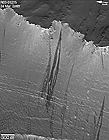
|
MOC2-1621-d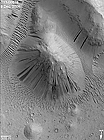
|
MOC2-1621-e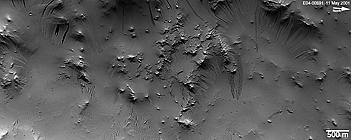
|
MOC2-1621-f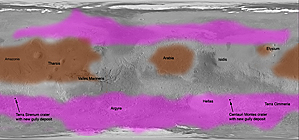
|
MOC2-1621-g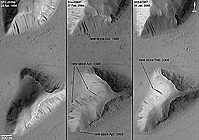
|
MOC2-1621-h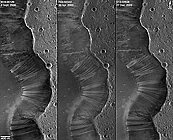
|
MOC2-1621-i
|
MOC2-1621-j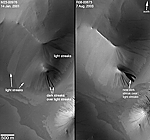
|
The light-toned deposits that formed in two gully sites on Mars during the Mars Global Surveyor (MGS) Mars Orbiter Camera (MOC) mission in the 1999 to 2005 period are considered to be the result of sediment transport by a fluid with the physical properties of liquid water. The young, light-toned gully deposits were found in a crater in Terra Sirenum (see New Gully Deposit in a Crater in Terra Sirenum) and in a crater east of the Hellas basin in the Centauri Montes region (see New Gully Deposit in a Crater in the Centauri Montes Region).
In their study of how the light-toned gully deposits may have formed, the MOC team considered their resemblance to light- and dark-toned slope streaks found elsewhere on Mars. Slope streaks are most commonly believed to have formed by downslope movement of extremely dry, very fine-grained dust, through processes thought by some to be analogous to terrestrial snow avalanche formation. Figure 1 shows the light-toned gully deposit in the crater in the Centauri Montes region, compared with typical slope streaks and several examples in which the slope streak gives a strong impression of having been produced by fluid-like flow.
(A) MOC2-1621-a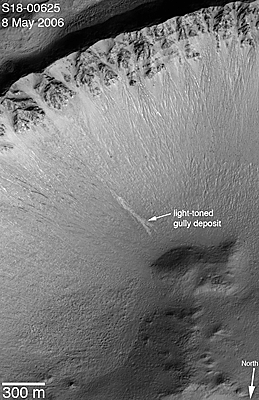 Fresh gully deposit, 38.7°S, 263.3°W Annotated Image – No Annotation |
(B) MOC2-1621-b Typical dark slope streaks, 0.1°N, 322.0°W Annotated Image – No Annotation |
(C) MOC2-1621-c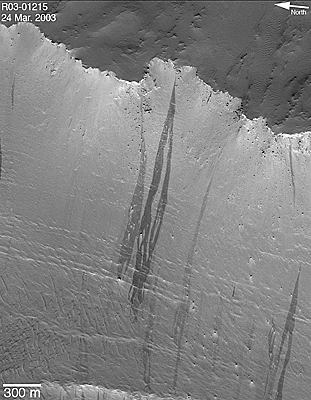 Streak diversion around obstacles, 13.5°N, 325.4°W Annotated Image – No Annotation |
(D) MOC2-1621-d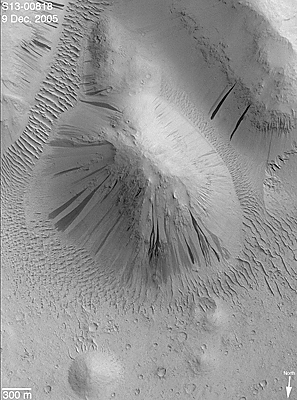 Streak diversion around obstacles, 1.5°S, 202.9°W Annotated Image – No Annotation |
|
Figure 1. The fresh, light-toned gully deposits have some resemblance to slope streaks.
(A) Light-toned gully deposit that formed between August 1999 and February 2004
in a crater in the Centauri Montes region of Mars.
(B) Typical dark slope streaks, as seen in a valley in central Arabia Terra. Hundreds of MOC
images have shown that the darkest streaks are the youngest; commonly, the darkest streaks are less
than a few years old.
(C) Dark slope streaks on a slope surrounding a pedestal crater in Tikhonravov Crater in Arabia
Terra. These streaks, particularly the two near the center of the image, show evidence that the downslope
movement of debris was diverted around obstacles, particularly large boulders.
(D) Dark slope streaks, including some that diverted around obstacles, on knobs in the Aeolis
region of Mars. The 300 meter scale bars are about 328 yards across; the 150 meter bar is 164 yards.
|
As shown in Figure 2, slope streaks can be lighter or darker than their surroundings. The majority of them are dark, and nearly always when light streaks are present, dark ones are nearby. This observation differs from the two light-toned gully deposits observed in Terra Sirenum and the Centauri Montes regions. In the case of the light-toned gully deposits, no dark slope streaks are present anywhere within the craters that they formed. As far as can we can tell, based on MGS MOC and Mars Odyssey Thermal Emission Imaging Spectrometer (THEMIS) coverage, there are no dark slope streaks within hundreds of kilometers of the two gully deposits.
MOC2-1621-e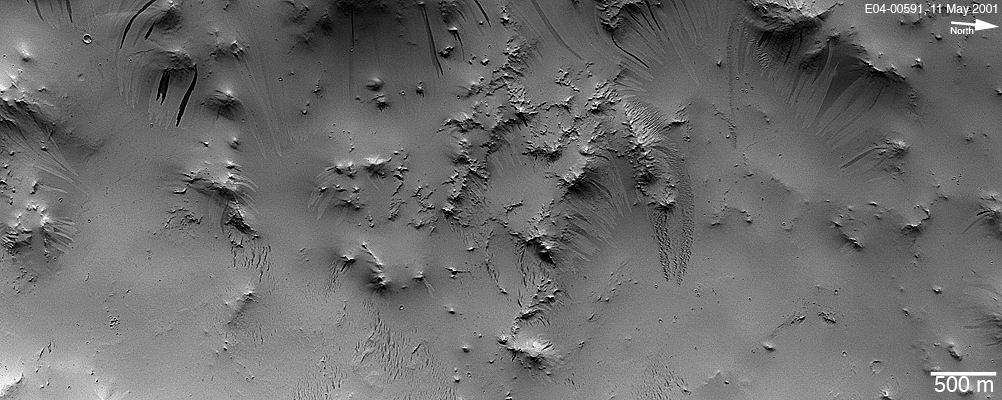 Light and dark slope streaks in Arabia Terra, 14.8°N, 332.4°W Annotated Image – No Annotation |
|
Figure 2.
Slope streaks of both light and dark tone, relative to their surrounding surfaces, in central
Arabia Terra. Where light slope streaks are found, dark ones are almost always nearby. The
500 meter scale bar is about 547 yards across.
|
Figure 3 shows that light and dark slope streaks occur in very specific regions (brown-shaded areas; particularly Tharsis, Amazonis, and near Elysium), and the gullies occur in different regions (pink-shaded areas; particularly middle northern and southern latitudes). In other words, the two fresh, light-toned gully deposits observed by MOC occur very far from the regions in which light and dark slope streaks are found. Indeed, the regions in which slope streaks occur are those that are most thickly covered with mantles of dust. Experience from driving the Sojourner and Mars Exploration Rover, Spirit, on dusty surfaces shows that when the uppermost coating of fine, bright dust is disturbed, the underlying surface is darker. Thus, dark slope streaks are considered to be areas where dust has been disturbed and slid downhill by dry, granular flow. The dust is extremely fine, like the flour used to bake bread.
MOC2-1621-f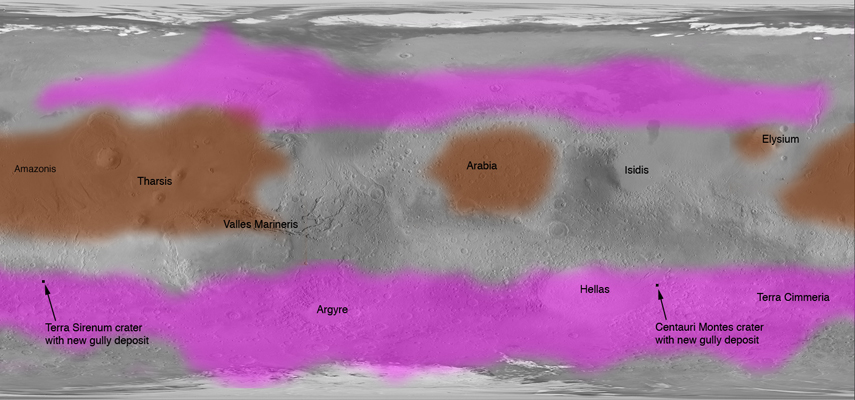 Map of Mars, simple cylindrical projection with poles at top and bottom, 180°W on sides, Prime Meridian down the center. Annotated Map |
|
Figure 3.
This map of Mars shows areas where gullies occur, shaded in pink, and where light and dark slope streaks
occur, shaded in brown. The location of the two craters in which MGS MOC observed new, light-toned gully
deposits are indicated. Except for a small portion of Tempe Terra (northeast of Tharsis), gullies and
slope streaks do not occur together in the same regions. Slope streaks occur in regions that have been
known since the Viking orbiter missions to be thickly mantled with dust. Gullies occur at middle and
high latitudes, where dust mantles are not so thick. The pink-shaded gully area is based upon the MOC team’s
survey of over 96,000 MOC narrow angle camera images. The brown-shaded area, representing light and dark
slope streak occurrences, comes from a combination of the MOC team’s assessment and the published results of
O. Aharonson, N. Schorghofer, and M. F. Gerstell (2003) Slope streak formation and dust deposition rates on Mars, Journal of Geophysical Research, v. 108, no. E12, doi:10.1029/2003JE002123.
|
New dark slope streaks are forming on Mars all the time. MGS MOC images have captured hundreds of before-and-after examples. Figure 4 shows one site that MOC monitored in the Elysium/Cerberus region.
MOC2-1621-g New dark slope streaks are forming all the time, 6.4°N, 201.2°W Annotated Image – No Annotation |
|
Figure 4.
The MOC narrow angle camera has acquired hundreds of images that repeat locations
where slope streaks occur. In so doing, MOC captured hundreds of cases where new
slope streaks formed. New streaks are always dark, not light. Several examples
on hillslopes in the Elysium/Cerberus region are shown here, spanning a period
from April 1998 through January 2005. The 300 meter scale bar equals about 328 yards.
|
New slopes streaks are always dark. No new light slope streaks have been observed by MOC, despite monitoring over the past 7–9 years at dozens of locations. Figure 5 shows one such example on the wall of Bahram Vallis, in which a suite of light slope streaks remained unchanged over a period spanning September 2000 through December 2005.
MOC2-1621-h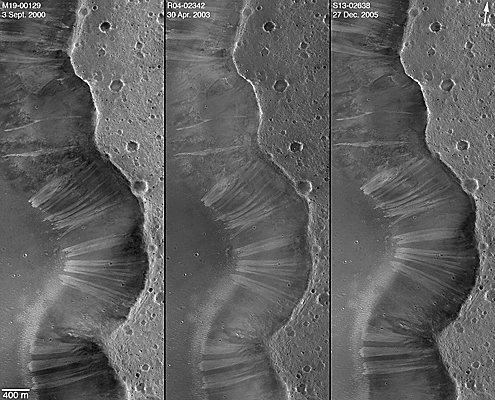 Light slope streaks are not forming, 21.2°N, 56.9°W Annotated Image – No Annotation |
|
Figure 5.
Light slope streaks are more rare than dark slope streaks. Curious as
to whether new light streaks form under present conditions, just as
new dark streaks do, the MOC team monitored dozens of light slope
streak sites. But no new light slope streaks have been observed. This
time series includes images from 2000, 2003, and 2005; no new streaks
formed during this period. The 400 meter scale bar is about 437 yards
across.
|
Not only have no new light slope streaks been observed, dark streaks have been seen to superpose (i.e., formed or were deposited on top of) light streaks. Figure 6a shows a case where several dark streaks are superimposed on several light streaks. Figure 6b shows a before-and-after example, in which a new dark streak wiped out underlying, older light slope streaks.
(A) MOC2-1621-i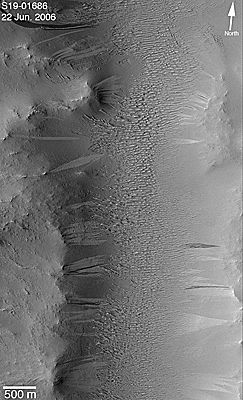 Light and dark slope streaks, 11.4°N, 328.1°W Annotated Image – No Annotation |
(B) MOC2-1621-j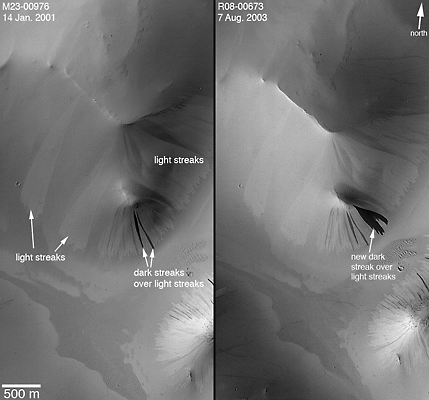 New dark streak over light streaks, 15.3°N, 317.8°W Annotated Image – No Annotation |
|
Figure 6.
MOC images show that dark slope streaks always superpose light slope streaks, never the other
way around. This observation reinforces the view that light slope streaks are not formed by the
downslope movement of dust—when dust moves, it creates a dark streak. Light streaks might therefore
be old dark streaks, perhaps trapping light-toned dust better than the adjacent, intermediate-toned
slopes. (A) Light and dark slope streaks on the wall of an unnamed valley in central Arabia
Terra. Dark streaks in some cases superpose light streaks. (B) Light and dark slope streaks in
Arabia Terra in an example where a new, large dark streak formed sometime between January 2001
and August 2003. The new dark streak formed on top of older light slope streaks.
The 500 meter scale bars are about 547 yards across.
|
The MGS MOC team’s experience, gained from examining all of the more than 96,000 MOC narrow angle camera images—and seeking evidence for changes among gullies, slope streaks, and other variable features on the planet’s surface—is that slope streaks form on very dusty slopes, the newest ones are dark, and older ones lighten with time as new dust is deposited on them. The origin of light slope streaks is not known, although we suspect they are related to dark slope streaks. Dark slope streaks may be dark because they have lost their light dust cover or because disturbed surfaces often have micro-relief that casts miniature shadows on the surface. Slope streaks that are lighter than their surroundings may have trapped newly-fallen dust within this microrelief, and may do so more effectively than adjacent, smooth slopes.
Slope streaks have attributes that indicate they experienced fluidized motion, but the fluid was less viscous (more fluid) than water-lubricated dirt. As with snow avalanches, the “fluid” was probably atmospheric gas ingested and intimately mixed with the dust as it began and continued to move downslope. Such air-fluidized flows stop more abruptly than do water-fluidized flows on comparable slopes.
In developing geologic interpretations from inspection of images, many factors are considered: size, relief, shape and pattern, color or brightness, texture, and association (context). Context is often the final discriminator between features that look similar. It is undeniable that the gully deposits resemble slope streaks, but they do not share the same context. If they are slopes streaks formed by downslope movement of dry, unconsolidated dust, then they are extremely rare features, because the new gully deposits (a) do not occur in regions where slope streaks occur, (b) are not found near any dark slope streaks, while typical light slope streaks have dark ones nearby, and (c) formed during the MGS MOC mission, while no new light slope streaks were observed to have formed anywhere else on the planet during the mission. Conversely, their presence within craters with gullies and the existence of similar light-toned features on other gullied (and in some cases on adjacent) slopes, with which they share geomorphic attributes, may be coincidental but is probably not. The gullies themselves provide the context for the gully deposits, and argue for a genetic relationship.
Accompanying captioned releases regarding gullies on Mars:
- New Gully Deposit in a Crater in Terra Sirenum:
Evidence That Water Flowed on Mars in This Decade?
- New Gully Deposit in a Crater in the Centauri Montes Region:
Evidence That Water Flowed on Mars During the Past 7 Years?
- Other Martian Gullies With Light-Toned Deposits
- Support for Hypothesis that Groundwater is Source for Fluid Responsible
for Erosion in Martian Gullies
Malin Space Science Systems and the California Institute of Technology built the MOC using spare hardware from the Mars Observer mission. MSSS operates the camera from its facilities in San Diego, California. The Jet Propulsion Laboratory's Mars Surveyor Operations Project operates the Mars Global Surveyor spacecraft with its industrial partner, Lockheed Martin Astronautics, from facilities in Pasadena, California and Denver, Colorado.
 To MSSS Home Page
To MSSS Home Page